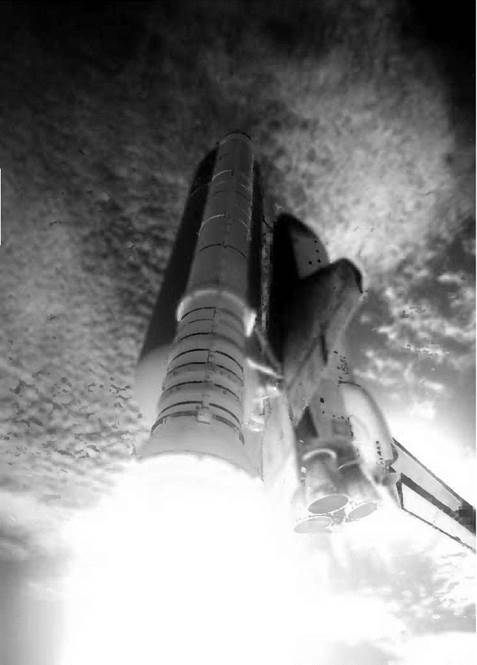Flight profiles
There are no “typical” space flights, as each mission is different by objective and flight profile. These profiles are determined by the geographical location of the launch site, the direction (azimuth) of launch, and the particular inclination and the height of the orbit above the planet. This can result, for example, in orbits over the polar caps, or out to a distance of 35,000 km (22,000 miles) which matches the rotation of the planet. This is where many of the communications and weather satellites are located, over the relevant part of the Earth, to maximize their capacity.
Of course, trajectories for leaving Earth orbit add to the complexity of the mission. For the Apollo lunar flights, even reaching for the Moon involved studies of three main trajectories. If the launch vehicle assigned had been large enough, then a direct flight to the Moon and back could have been flown—a profile termed “direct ascent”. As this was beyond the capabilities and funding to meet the 1970 deadline, the Americans chose an alternative route. The second option was to launch elements of the lunar spacecraft on separate, smaller rockets, and then bring the spacecraft together in orbit before continuing out towards the Moon. Called “Earth orbital rendezvous”, this method was far more challenging because it would have meant developing the capability for several on time launches, rendezvous and docking, and proximity operations that would be required to make the method a success. Any delays could seriously have threatened President Kennedy’s deadline and fallen behind the expected Soviet competition to the Moon.
The third option was to launch a two-part spacecraft, one of them a separate lander, on one large launch vehicle into Earth orbit. This landing vehicle would then be extracted unmanned from the top of the launch vehicle where it was stored for launch. Once joined up, the combination would be sent to the Moon with a crew of three astronauts and, once in lunar orbit, two of the crew would separate the lander to complete the surface exploration program with the third astronaut remaining in orbit. Creating a lighter vehicle to land on the Moon meant a lighter vehicle to lift off from the surface and a smaller engine required to be able to do so. After rendezvous, the main spacecraft would return to Earth with the crew of three. This system, though still risky, raised questions over whether to proceed and the capability of making various safety decisions throughout the mission. This method was called “lunar orbital rendezvous” and was the method chosen for the American Apollo missions, to great success. To gain the necessary experience in orbital rendezvous, longer duration missions, and spacewalking techniques NASA created the two-man Gemini program which completed 10 highly successful manned missions in Earth orbit during 1965 and 1966.

|
|
|
Circumlunar missions (flights around the far side of the Moon without entering orbit and then heading on back to Earth) were flown by unmanned Soviet Zond vehicles to test their lunar capabilities. Although no Soviet manned flights ever flew in competition to Apollo, it is known that the Soviets were developing their own manned lunar program. Initially, cosmonauts would have followed an Earth orbital rendezvous profile, but in 1964 this was amended to a probable lunar orbital rendezvous profile. Unfortunately, while the Americans chose LOR as the best way to develop Apollo, the argument in Russia was actually over which designers would be the lead bureau rather than which method to follow. Coupled with hardware failures and the success of the Americans, this led the Soviets to cancel their manned lunar program long before any cosmonauts left the launchpad to test the lunar hardware in space.
Since Apollo 17 in 1972, every manned orbital mission to date has been in Earth orbit, either on independent flight profiles or as a docking mission to a space station. Significant experience in orbital rendezvous was achieved by the Americans during the Gemini program (1965-1966) and with the Apollo era missions (1968-1975) but despite several rendezvous with satellites by the Shuttle, actual docking experience for Shuttle crews did not begin until the Shuttle-Mir program of 1995-1998, extending to the ISS assembly missions between 1998 and 2011.
For the Russians, the first manned docking occurred between Soyuz 4 and 5 in 1969, but it was as part of regular Soyuz-Salyut operations between 1971 and 1986, followed by extensive Mir operations during 1986 through 2000, that they gained significant experience of automated and manual docking. This was supplemented by experience with docking unmanned Progress resupply craft to Salyut, Mir, and then ISS from 1978. After over 40 years of docking Soyuz (and Progress) variants to space stations, the reliable Soyuz continues to be the mainstay of Earth orbital operations. In 2011, the Shenzhou 8 demonstrated Chinese unmanned space station docking capability and was followed the next year by the first docking of a crew, who completed both a manual and automated docking to Tiangong 1 aboard Shenzhou 9. Rendezvous and docking, plus station-keeping and proximity operations will remain a focal point of Earth orbital operations for the rest of this decade, 50 years after they were first demonstrated during Project Gemini.










